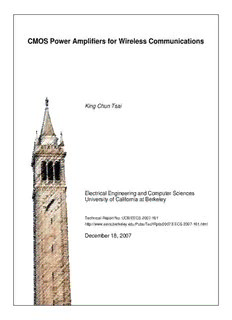
CMOS Power Amplifiers for Wireless Communications PDF
Preview CMOS Power Amplifiers for Wireless Communications
CMOS Power Amplifiers for Wireless Communications King Chun Tsai Electrical Engineering and Computer Sciences University of California at Berkeley Technical Report No. UCB/EECS-2007-161 http://www.eecs.berkeley.edu/Pubs/TechRpts/2007/EECS-2007-161.html December 18, 2007 Copyright © 2007, by the author(s). All rights reserved. Permission to make digital or hard copies of all or part of this work for personal or classroom use is granted without fee provided that copies are not made or distributed for profit or commercial advantage and that copies bear this notice and the full citation on the first page. To copy otherwise, to republish, to post on servers or to redistribute to lists, requires prior specific permission. CMOS Power Amplifiers for Wireless Communications by King Chun Tsai B.S. (Boston University) 1994 A dissertation submitted in partial satisfaction of the requirements for the degree of Doctor of Philosophy in Engineering-Electrical Engineering and Computer Sciences in the GRADUATE DIVISION of the UNIVERSITY of CALIFORNIA, BERKELEY Committee in charge: Professor Paul R. Gray, Chair Professor Seth R. Sanders Professor Paul K. Wright Fall 2007 The dissertation of King Chun Tsai is approved: Chair _________________________________________ Date ______________ _________________________________________ Date ______________ _________________________________________ Date ______________ University of California, Berkeley Fall 2007 CMOS Power Amplifiers for Wireless Communications Copyright © 2007 by King Chun Tsai Abstract CMOS Power Amplifiers for Wireless Communications by King Chun Tsai Doctor of Philosophy in Electrical - Electrical Engineering and Computer Sciences University of California, Berkeley Professor Paul R. Gray, Chair The advancement of CMOS technology has enabled an unprecedented level of integration in modern low cost, small form-factor and low power wireless devices. While Power Amplifies (PAs) are key components in wireless transceivers, their realization and integration in standard CMOS technology is hindered by a number of technological challenges. One fundamental challenge of high efficiency CMOS PA realization is the low breakdown voltage of thin gate oxide devices. It forces high output power CMOS PAs to operate under high-current, low-impedance levels where they are vulnerable to parasitic losses. Other challenges include the limited intrinsic gain and large parasitic capacitance and resistance of CMOS transistors, as well as the lack of high quality factor monolithic passive components. This thesis addresses these challenges and demonstrates an RF CMOS power amplifier that is suitable for amplification of constant envelope modulated signals that are widely 1 used in cellular systems such as GSM. The key design innovations include (1) the use of a differential switch-mode Class-E structure to optimize power efficiency, extend power capacity, and minimize the impact of substrate noise injection; (2) the use of injection locking technique to significantly reduce the input driving requirement of large transistors; and (3) the design of a compact hybrid balun to interface the differential PA with any conventional signal-ended RF load. The effectiveness of these techniques is demonstrated in a PA prototype that is fabricated in a standard 0.35um CMOS process. The prototype operates up to 2GHz and is capable of delivering 1 Watt of output power with a 48% power-added efficiency (41% including the balun). Comparing with its predecessors, this prototype demonstrates a new level of operational frequency, output power and power efficiency achievable by CMOS power amplifiers. ___________________________________ Professor Paul R. Gray, Chair 2 Acknowledgements First and foremost, I would like to express my deep and sincere gratitude to my supervisor Prof. Paul R. Gray for his guidance, patience and encouragement. His insist on excellence remains a beacon in my personal and professional lives. I also thank Professors Seth R. Sanders and Paul K. Wright for dedicating their time in reviewing this thesis. The years in Berkeley have been the most inspiring and satisfying experience for me. I enjoyed every moment of it and I am grateful to the faculty of the EECS department for putting together such a fine program. The teachings of Professors Paul R. Gray, Robert G. Meyer, Bernhard E. Boser, Chenming Hu, and Edward A. Lee, in particular have induced great interest and continue to be a source of aspiration. I also appreciate the friendship and altruism of the comrades at Cory Hall and BWRC. I am deeply indebt to the C.W. Chu foundation whose generous scholarship gave me the opportunity to pursue higher education in the United States. I owe my sincere gratitude also to Prof. Ted Moustakas of Boston University who plays a pivotal role in my education. Last but certainly not least, I am grateful to my parents Kuang Sun Tsai and Ho Chi Lau for their sacrifice and supports. My special gratitude also goes to my wife Stella Tse whose patient love has accompanied me through the toughest times, and I am looking forward to a long and joyful life with her and our family. King Chun Tsai i Table of Contents Chapter 1 - Introduction.....................................................................................1 1.1 Background............................................................................................................................1 1.2 The challenges of CMOS PA.................................................................................................5 1.3 Pioneering Developments in CMOS PAs..............................................................................6 1.4 Research Goal.......................................................................................................................7 1.5 Thesis Organization...............................................................................................................8 Chapter 2 - Power Amplification Fundamentals............................................12 2.1 A conceptual model for Power Amplifier..............................................................................12 2.2 The Matching Network.........................................................................................................14 2.3 Key Power Amplifier Performance Parameters...................................................................18 Chapter 3 - Transconductor-based Power Amplifiers...................................27 3.1 Introduction..........................................................................................................................27 3.2 Class-A, AB, B and C Power Amplifiers..............................................................................29 3.3 Class-A Power Amplifiers....................................................................................................31 3.4 Reduced Conduction Angle Power Amplifiers.....................................................................35 3.5 Class-F1 Power Amplifier....................................................................................................54 Chapter 4 - Switch-mode Power Amplifiers...................................................62 4.1 Switch-mode vs. Transconductance-based PAs.................................................................62 ii 4.2 Class-F2 power amplifier.....................................................................................................64 4.3 Class-D Power Amplifier......................................................................................................71 4.4 Effects of finite load network Q on Harmonic Distortion......................................................79 4.5 Effects of Finite Load Network Q on Efficiency...................................................................82 4.6 Summary.............................................................................................................................87 Chapter 5 - Power Amplifier Implementation Technologies.........................89 5.1 Introduction..........................................................................................................................89 5.2 GaAs MESFET....................................................................................................................90 5.3 GaAs HBT............................................................................................................................96 5.4 SiGe HBT...........................................................................................................................105 5.5 CMOS................................................................................................................................109 Chapter 6 - Analysis of Class-E PA...............................................................117 6.1 Introduction........................................................................................................................117 6.2 Hard-switching vs. Soft-switching......................................................................................118 6.3 Class-E operation..............................................................................................................120 6.4 Class-E PA characteristics................................................................................................123 6.5 Theoretical Analysis of Class-E PA operation...................................................................126 6.6 Considerations on Power Control......................................................................................144 6.7 Summary...........................................................................................................................146 Chapter 7 - Design of a 1-W 1.9GHz CMOS Class-E PA..............................147 7.1 Introduction........................................................................................................................147 7.2 Circuit Schematic...............................................................................................................148 iii
Description: